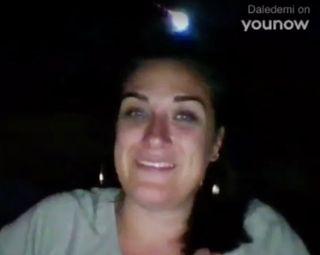Gorgeous Green 'San Diego Fireball' Lights Up Western Sky (Video)

A bright fireball blazed up Monday night (April 10) over the southwestern United States, dazzling observers in Nevada, Arizona and Southern California.
The meteor was spotted at about 9:00 p.m. PDT (10:00 p.m. MDT; midnight EDT and 0400 GMT on Tuesday, April 11). Videos of the event show a bright green streak that flares up three or four separate times before fading into the darkness.
One of these videos is a live stream recorded by Faye Heddings in East Lake, near San Diego. The meteor flashes overhead behind her, in a memorable fireball photobomb.
"Did you guys see that?" Heddings says in the video, her eyes wide. "Did you guys see that?"
"The preliminary estimated trajectory plotted from the witness reports shows the meteor was traveling from the east to west and ended its visible flight on the Pacific Ocean somewhere over the San Diego Trough," wrote representatives with the American Meteor Society (AMS), which had received more than 400 reports of the "San Diego Fireball" as of Tuesday afternoon.

Just seven people have reported hearing a noise associated with the meteor so far, AMS representatives added. (Such meteor sounds have long puzzled scientists. But a recent study suggests that they're likely caused by bright pulses of fireball light, which heat up hair, fabric and other material near observers' ears, generating pressure waves that manifest as sound.)
About 100 tons of space material falls into Earth's atmosphere every day. Most of this stuff is dust, and it burns up without leaving a noticeable trace. But some incoming space rocks are big enough to make a visible trail — and some of these blaze up brighter than Venus, meeting the technical definition of "fireball."
Get the Space.com Newsletter
Breaking space news, the latest updates on rocket launches, skywatching events and more!
Such events aren't terribly uncommon. A spectacular fireball wowed observers in the Milwaukee area in February, for example, and a handful of other such events made news in 2016. And sometimes humanity sets the stage for the skywatching show: One of last year's brightest fireballs was caused by a 6-ton Chinese rocket stage that fell back to Earth on July 27.
Here are some videos of Monday's San Diego Fireball that observers posted on YouTube:
Editor's note: If you capture an amazing image of a fireball or any other night-sky view that you'd like to share, you can send it to managing editor Tariq Malik at spacephotos@space.com.
Follow Mike Wall on Twitter @michaeldwall and Google+. Follow us @Spacedotcom, Facebook or Google+. Originally published on Space.com.
Join our Space Forums to keep talking space on the latest missions, night sky and more! And if you have a news tip, correction or comment, let us know at: community@space.com.

Michael Wall is a Senior Space Writer with Space.com and joined the team in 2010. He primarily covers exoplanets, spaceflight and military space, but has been known to dabble in the space art beat. His book about the search for alien life, "Out There," was published on Nov. 13, 2018. Before becoming a science writer, Michael worked as a herpetologist and wildlife biologist. He has a Ph.D. in evolutionary biology from the University of Sydney, Australia, a bachelor's degree from the University of Arizona, and a graduate certificate in science writing from the University of California, Santa Cruz. To find out what his latest project is, you can follow Michael on Twitter.
